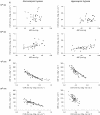Intrauterine growth restriction improves cerebral O2 utilization during hypercapnic hypoxia in newborn piglets
- PMID: 17717008
- PMCID: PMC2277152
- DOI: 10.1113/jphysiol.2007.142778
Intrauterine growth restriction improves cerebral O2 utilization during hypercapnic hypoxia in newborn piglets
Abstract
Data are scant regarding the capacity of cerebrovascular regulation during asphyxia for prevention of brain oxygen deficit in intrauterine growth-restricted (IUGR) newborns. We tested the hypothesis that IUGR improves the ability of neonates to withstand critical periods of severe asphyxia by optimizing brain oxygen supply. Studies were conducted to examine the effects of IUGR on cerebral blood flow (CBF) regulation and oxygen consumption (cerebral metabolic rate for oxygen, CMRO(2)) at different stages of asphyxia (hypercapnic hypoxaemia) in comparison to pure hypoxia (normocapnic hypoxaemia). We used 1-day-old anaesthetized and ventilated piglets. Animals were divided into normal weight (NW) piglets (n = 47; aged 11-26 h, body weight 1481 +/- 121 g) and IUGR piglets (n = 48; aged 13-28 h, body weight 806 +/- 42 g) according to their birth weight. Different stages of hypoxaemia were induced for 1 h by appropriate lowering of the inspired fraction of oxygen (moderate hypoxia: = 31-34 mmHg; severe hypoxia: = 20-22 mmHg). Fourteen NW and 16 IUGR piglets received additionally 9% CO(2) in the breathing gas, so that a of 74-80 mmHg resulted (hypoxia/hypercapnia groups). Eight NW and nine IUGR animals served as untreated controls. Furthermore, affinity of haemoglobin for oxygen was measured under hypoxic and asphyxic conditions. During asphyxia cerebral oxygen extraction was markedly increased in IUGR animals (P < 0.05). This resulted in a significantly diminished CMRO(2)-related increase of CBF at gradually reduced arterial oxygen content (P < 0.05). Therefore, an enhanced effectivity in oxygen availability appeared in newborn IUGR piglets under graded asphyxia by improved cerebral oxygen utilization (P < 0.05). This was not supported by related O(2) affinity of haemoglobin. Thus, IUGR newborns are more capable to ensure brain O(2) demand during asphyxia (hypercapnic hypoxia) than NW neonates.
Figures



 = 40.2 ± 1.1 mmHg; IUGR: n= 6,
= 40.2 ± 1.1 mmHg; IUGR: n= 6,  = 40.5 ± 1.2 mmHg) and hypercapnia (NW: n= 8,
= 40.5 ± 1.2 mmHg) and hypercapnia (NW: n= 8,  = 78.4 ± 7.5 mmHg; IUGR: n= 8,
= 78.4 ± 7.5 mmHg; IUGR: n= 8,  = 81.2 ± 5.3 mmHg) on the half-saturation oxygen pressure (P50) of normal weight (NW, open columns) and intrauterine growth-restricted newborn piglets (IUGR, filled columns). Values are presented as means +
= 81.2 ± 5.3 mmHg) on the half-saturation oxygen pressure (P50) of normal weight (NW, open columns) and intrauterine growth-restricted newborn piglets (IUGR, filled columns). Values are presented as means +Similar articles
-
Intrauterine growth restriction ameliorates the effects of gradual hemorrhagic hypotension on regional cerebral blood flow and brain oxygen uptake in newborn piglets.Pediatr Res. 2004 Oct;56(4):639-46. doi: 10.1203/01.PDR.0000139425.94975.77. Epub 2004 Aug 4. Pediatr Res. 2004. PMID: 15295090
-
Cardiovascular function and brain metabolites in normal weight and intrauterine growth restricted newborn piglets--effect of mild hypoxia.Exp Toxicol Pathol. 1998 Sep;50(4-6):294-300. doi: 10.1016/S0940-2993(98)80009-2. Exp Toxicol Pathol. 1998. PMID: 9784001
-
Effect of moderate hypercapnic hypoxia on cerebral dopaminergic activity and brain O2 uptake in intrauterine growth-restricted newborn piglets.Pediatr Res. 2005 Mar;57(3):363-70. doi: 10.1203/01.PDR.0000150800.19956.F0. Epub 2004 Dec 20. Pediatr Res. 2005. PMID: 15611347
-
Interaction between systemic circulation and brain injuries in newborns.Exp Pathol. 1991;42(4):197-203. doi: 10.1016/s0232-1513(11)80065-4. Exp Pathol. 1991. PMID: 1959579 Review.
-
Regional Cerebrovascular Responses to Hypercapnia and Hypoxia.Adv Exp Med Biol. 2016;903:157-67. doi: 10.1007/978-1-4899-7678-9_11. Adv Exp Med Biol. 2016. PMID: 27343095 Review.
Cited by
-
The effect of prenatal nicotine on expression of nicotine receptor subunits in the fetal brain.Neurotoxicology. 2008 Jul;29(4):722-6. doi: 10.1016/j.neuro.2008.04.015. Epub 2008 May 2. Neurotoxicology. 2008. PMID: 18541304 Free PMC article.
-
Zika Virus Causes Persistent Infection in Porcine Conceptuses and may Impair Health in Offspring.EBioMedicine. 2017 Nov;25:73-86. doi: 10.1016/j.ebiom.2017.09.021. Epub 2017 Sep 21. EBioMedicine. 2017. PMID: 29097124 Free PMC article.
-
Postnatal functional integrity of the brainstem auditory pathway in late preterm infants born of small-for-gestation age: how different from those born of appropriate-for-gestation.Eur J Pediatr. 2024 Jul;183(7):3041-3051. doi: 10.1007/s00431-024-05571-x. Epub 2024 Apr 23. Eur J Pediatr. 2024. PMID: 38652266
-
Cardiovascular responses to mild perinatal asphyxia in growth-restricted preterm lambs.Am J Physiol Heart Circ Physiol. 2023 Nov 1;325(5):H1081-H1087. doi: 10.1152/ajpheart.00485.2023. Epub 2023 Sep 1. Am J Physiol Heart Circ Physiol. 2023. PMID: 37656131 Free PMC article.
-
Parturition and Its Relationship with Stillbirths and Asphyxiated Piglets.Animals (Basel). 2019 Oct 31;9(11):885. doi: 10.3390/ani9110885. Animals (Basel). 2019. PMID: 31683527 Free PMC article. Review.
References
-
- Anday EK, Lien R, Goplerud JM, Kurth CD, Shaw LM. Pharmacokinetics and effect of cocaine on cerebral blood flow in the newborn. Dev Pharmacol Ther. 1993;20:35–44. - PubMed
-
- Aplin J. Maternal influences on placental development. Semin Cell Dev Biol. 2000;11:115–125. - PubMed
-
- Ashworth A. Effects of intrauterine growth retardation on mortality and morbidity in infants and young children. Eur J Clin Nutr. 1998;52(Suppl. 1):S34–S41. - PubMed
-
- Bauer R, Bergmann R, Walter B, Brust P, Zwiener U, Johannsen B. Regional distribution of cerebral blood volume and cerebral blood flow in newborn piglets – effect of hypoxia/hypercapnia. Brain Res Dev Brain Res. 1999;112:89–98. - PubMed
-
- Bauer R, Walter B, Bauer K, Klupsch R, Patt S, Zwiener U. Intrauterine growth restriction reduces nephron number and renal excretory function in newborn piglets. Acta Physiol Scand. 2002;176:83–90. - PubMed
Publication types
MeSH terms
Substances
LinkOut - more resources
Full Text Sources

